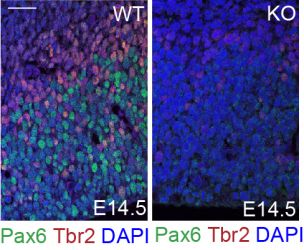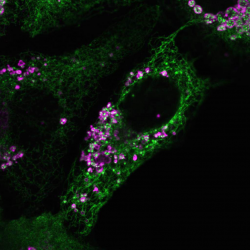News from the Institute

The IBC2 research group of Stefanie Oess recently discovered that the protein Nosip is crucial for the function of neural stem/progenitor cells and thus critical for the complex process of brain development. In previous work, the group had already elucidated that the E3 ligase Nosip is a regulator of forebrain and craniofacial development in mice.
In their latest study, the researchers now combined in vivo and in vitro techniques and applied state-of-the-art proteomics to describe a novel function of Nosip upstream of Retinol-binding protein 1 (Rbp1) in early neurogenesis.
... (read more)
Today, the German Research Foundation (DFG) announced the establishment of a new Research Unit (FOR 2625) on the mechanisms of lysosomal homeostasis.
The Unit is led by Thomas Braulke from the University Medical Center Hamburg-Eppendorf, with 13 research groups from Germany and one from The Netherlands taking part. From IBC2, Anja Bremm and Ivan Dikic are on board, bringing in their expertise in ubiqiuitin signaling and deciphering how ubiquitin regulates lysosome function.
... (read more)
Rahel de Bruyn from the Kaulich group is one of the winners of this years’ poster prize at the 8th Mildred Scheel Cancer Conference (MSCC) in Bonn. She was awarded for her outstanding work on the tumor suppressor RB1 which controls cell cycle entry.
If a cell is not ready for DNA replication, RB1 halts further progression of the cell cycle in G1 phase. Thereby, it prevents the replication of damaged DNA which may lead to detrimental mutations and cancer development, as seen in retinoblastoma patients who carry a mutated RB1 gene.
... (read more)
The endoplasmic reticulum (ER) is the cell’s largest and probably most versatile organelle. It consists of extended membrane structures, which are constantly remodeled to ensure functionality in all cellular states. Degradation of the ER is mediated by a specialized form of selective autophagy (ER-phagy), a process which is until now not very well understood.
An international team around Ivan Dikic has identified Reticulon 3 (the full-length form of RTN3) as a selective receptor which specifically triggers fragmentation of ER tubules and their delivery to lysosomes. The process requires the core autophagy machinery but is independent of FAM134B, the first ER-phagy receptor previously identified by Dikic’s group. FAM134B is responsible for targeting ER sheets rather than ER tubules.
... (read more)
This was the slogan of a public TEDx event in Zagreb, at which IBC2 director Ivan Dikic shared his thoughts about what can be learnt from bacteria. It was the largest Croatian TED event ever, full of enthusiasm, creativity and inspiration.
The 20 speakers came from many different areas of society, and all gave one major motivation message: boundaries can be broken if we just strive hard enough.
... (read more)